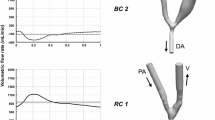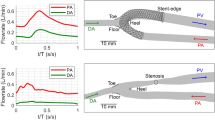Abstract
The study focuses on arterial stenoses in arteriovenous fistulae (AVF), the occurrence of which was long underestimated. The objective is to investigate their influence on the hemodynamic conditions within the AVF. A numerical simulation of the blood flow is conducted within a patient-specific arteriovenous fistula that presents an 60% stenosis on the inflow artery. In order to find the vessel shape without stenosis and compare the flow conditions with and without stenosis, the endovascular treatment of balloon-angioplasty is simulated by modeling the vessel deformation during balloon inflation implicitly. Clinically, balloon-angioplasty is considered successful if the post-treatment residual degree of stenosis is below 30%. Different balloon inflation pressures have been imposed numerically to obtain residual degrees of stenosis between 30 and 0%. The comparison of the computational fluid dynamic simulations carried out in the patient-specific native geometry and in the treated ones shows that the arterial stenosis has little impact on the blood flow distribution. The venous flow rate remains unchanged as long as thrombosis does not occur: the nominal flow rate needed for hemodialysis is maintained, which is not the case for a venous stenosis. An arterial stenosis, however, causes an increase in the pressure difference across the stenosed region. A residual degree of stenosis below 20% is needed to guarantee a pressure difference lower than 5 mmHg, which is considered to be the threshold stenosis pressure difference.






Similar content being viewed by others
References
ANSYS Academic Research, Release 13.0, Help System. ANSYS Inc, 2010.
Asif, A., F. N. Gadalean, D. Merrill, G. Cherla, C. D. Cipleu, D. L. Epstein, and D. Roth. Inflow stenosis in arteriovenous fistulas and grafts: a multicenter, prospective study. Kidney Int. 67:1986–1992, 2005.
Asif, A. Endovascular procedures. Contrib. Nephrol. 161:30–38, 2008.
Biuckians, A., B. C. Scott, G. H. Meier, J. M. Panneton, and M. H. Glickman. The natural history of autologous fistulas as first-time dialysis access in the KDOQI era. J. Vasc. Surg. 47:415–421, 2008.
Bogert, L. W. J., and J. J. van Lieshout. Non-invasive pulsatile arterial pressure and stroke volume changes from the human finger. Exp. Physiol. 90:437–448, 2005.
Chan, M. R., S. Bedi, R. J. Sanchez, H. N. Young, Y. T. Becker, P. S. Kellerman, and A. S. Yevzlin. Stent placement versus angioplasty improves patency of arteriovenous grafts and blood flow of arteriovenous fistulae. Clin. J. Am. Soc. Nephrol. 3:699–705, 2008.
Coentrpo, L., and L. Turmel-Rodrigues. Monitoring dialysis arteriovenous fistulae: its in our hands. J. Vasc. Access 14(3):209–215, 2013.
Corpataux, J. M., E. Haesler, P. Silacci, H. B. Ris, and D. Hayoz. Low-pressure environment and remodelling of the forearm vein in brescia-cimino haemodialysis access. Nephrol. Dial. Transpl. 17:1057–1062, 2002.
Decorato, I., Z. Kharboutly, T. Vassallo, J. Penrose, C. Legallais, and A.-V. Salsac. Numerical simulation of the fluid–structure interactions in a compliant patient-specific arteriovenous fistula. Int. J. Numer. Methods Biomed. Eng. 30:143–159, 2014.
Dixon, B. S. Why don’t fistulas mature? Kidney Int. 70:1413–1422, 2006.
Duijm, L. E. M., Y. S. Liem, R. van der Rijt, F. J. Nobrega, H. C. M. van der Bosch, P. Douwes-Draaijer, P. W. M. Cuypers, and A. V. Tielbeek. Inflow stenoses in dysfunctional hemodialysis access fistulas and grafts. Am. J. Kidney Dis. 48:98–105, 2006.
Ene-Iordache, B., L. Mosconi, G. Remuzzi, and A. Remuzzi. Computational fluid dynamics of a vascular access case for hemodialysis. J. Biomech. Eng. 123:284–292, 2001.
Fellström, B. C., A. G. Jardine, R. E. Schmieder, H. Holdaas, K. Bannister, J. Beutler, D.-W. Chae, A. Chevaile, S. M. Cobbe, C. Grönhagen-Riska, J. J. De Lima, R. Lins, G. Mayer, A. W. McMahon, H.-H. Parving, G. Remuzzi, O. Samuelsson, S. Sonkodi, G. Süleymanlar, D. Tsakiris, V. Tesar, V. Todorov, A. Wiecek, R. P. Wüthrich, M. Gottlow, E. Johnsson, and F. Zannad. Rosuvastatin and cardiovascular events in patients undergoing hemodialysis. N. Engl. J. Med., 360:1395–1407, 2009.
Forauer, A. R., E. K. Hoffer, and K. Homa. Dialysis access venous stenoses: treatment with balloon angioplasty1-versus 3-minute inflation times. Radiology, 249(1):375–381, 2008.
Gasser, T. C., and G. A. Holzapfel. Finite element modeling of balloon angioplasty by considering overstretch of remnant non-diseased tissues in lesions. Comput. Mech. 40:47–60, 2007.
Gervaso, F., C. Capelli, L. Petrini, S. Lattanzio, L. DiVirgilio, and F. Migliavacca. On the effects of different strategies in modelling balloon-expandable stenting by means of finite element method. J. Biomech. 41(6):1206–1212, 2008.
Green, A. E., and J. E. Adkins. Large Elastic Deformations. Oxford University Press, 1970.
Gutierrez, M. A., P. E. Pilon, S. G. Lage, L. Kopel, R. T. Carvalho, and S. S. Furuie. Automatic measurement of carotid diameter and wall thickness in ultrasound images. Comput. Cardiol. 29:359–362, 2002.
Horl, W. H., K. M. Koch, C. Ronco, and J. F. Winchester. Replacement of renal function by dialysis. Kluwer Academic Publishers, 2004.
Jackson, M., N. B. Wood, S. Zhao, A. Augst, J. H. Wolfe, W. M. W. Gedroyc, A. D. Hughes, S. A. M. c. G. Thom, and X. Y. Xu. Low wall shear stress predicts subsequent development of wall hypertrophy in lower limb bypass grafts. Arter. Res. 3:32–38, 2009.
Kharboutly, Z. M. Fenech, J. M. Treutenaere, I. Claude, and C. Legallais. Investigations into the relationship between hemodynamics and vascular alterations in an established arteriovenous fistula. Med. Eng. Phys. 29(9):999–1007, 2007.
Konner, K. History of vascular access for haemodialysis. Nephrol. Dial. Transpl. 20:2629–2635, 2005.
Lee, T., and P. Roy-Chaudhury. Advances and new frontiers in the pathophysiology of venous neointimal hyperplasia and dialysis access stenosis. Adv. Chronic Kidney Dis. 16(5):329–338, 2009.
Maher, E., A. Creane, S. Sultan, N. Hynes, C. Lally, and D. J. Kelly. Inelasticity of human carotid atherosclerotic plaque. Ann. Biomed. Eng. 39:2445–2455, 2011.
Merril, E. W., and G. A. Pelletier. Viscosity of human blood: transition from Newtonian to non-Newtonian. J. Appl. Physiol. 23:178–182, 1967.
Molino, P., C. Cerutti, C. Julien, G. Cusinaud, M. P. Gustin, and C. Paultre. Beat-to-beat estimation of windkessel model parameters in conscious rats. Am. J. Physiol. Heart Circ. Phisiol. 274:H171–H177, 1998.
Niemann, A. K., S. Thrysoe, J. V. Nygaard, J. M. Hasenkam, and S. E. Petersen. Computational fluid dynamics simulation of a-v fistulas: From MRI and ultrasound scans to numeric evaluation of hemodynamics. J. Vasc. Access 13(1):36–44, 2012.
Ozyer, U., A. Harman, E. Yildirim, C. Aytekin, F. Karakayali, and F. Boyvat. Long-term results of angioplasty and stent placement for treatment of central venous obstruction in 126 hemodialysis patients: a 10-year single-center experience. Am. J. Roentgenol. 193:1672–1679, 2009.
Prendergast, P. J., C. Lally, S. Daly, A. J. Reid, T. C. Lee, D. Quinn, and F. Dolan. Analysis of prolapse in cardiovascular stents: a constitutive equation for vascular tissue and finite-element modelling. J. Biomech. Eng. 125:692–699, 2003.
Rhie, C. M., and W. L. Chow. Numerical study of the turbulent flow past an airfoil with trailing edge separation. AIAA J. 21:1525–1532, 1983.
Salman, L., M. Ladino, M. Alex, R. Dhamija, D. Merrill, O. Lenz, G. Contreras, and A. Asif. Accuracy of ultrasound in the detection of inflow stenosis of arteriovenous fistulae: results of a prospective study. Semin. Dial. 23:117–121, 2010.
Sarnak, M. J. Cardiovascular complications in chronic kidney disease. Am. J. Kidney Dis. 41:11–17, 2003.
Singh, P. K., A. Marzo, C. Staicu, M. G. William, I. Wilkinson, P. V. Lawford, D. A. Rufenacht, P. Bijlenga, A. F. Frangi, R. Hose, U. J. Patel, and S. C. Coley. The effects of aortic coarctation on cerebral hemodynamics and its importance in the etiopathogenesis of intracranial aneurysms. J. Vasc. Int. Neurol. 3:17–30, 2010.
Swinnen, J. Duplex ultrasound scanning of the autogenous arterio venous hemodialysis fistula: a vascular surgeon’s perspective. AJUM 14:17–23, 2011.
Timoshenko, S. P., and J. N. Goodier. Timoshenko and Gore: Theory of Elastic Stability: Theory of Elasticity. McGraw-Hill, 1970.
Tordoir, J. H. M., H. G. Debruin, H. Hoeneveld, B. C. Eikelboom, and P. Kitslaar. Duplex ultrasound scanning in the assessment of arteriovenous fistulas created for hemodiafysis access—comparison with digital subtraction angiography. J. Vasc. Surg. 10:122–128, 1989.
van Tricht, I., D. DeWachter, J. Tordoir, and P. Verdonk. Hemodynamics and complications encountered with arteriovenous fistulas and grafts as vascular access for hemodialysis: a review. Ann. Biomed. Eng. 33:1142–1157, 2005.
Westerhof, N., F. Bosman, C. J. De Vries, and A. Noordergraaf. Analog studies of the human systemic arterial tree. J. Biomech. 2:121–143, 1969.
Yeoh, O. H. Some forms of the strain energy function for rubber. Rubber Chem. Technol. 66:754–771, 1993.
Yerdel, M. A., M. Kesence, K. M. Yazicuoglu ans, Z. Doseyen, A. G. Turkcapar, and E. Anadol. Effect of hemodynamic variables on surgically created arteriovenous fistula flow. Nephrol. Dial. Transpl. 12:1684–1688, 1997.
Young, D. F. Fluid mechanics of arterial stenoses. J. Biomech. Eng. 101:157175, 1979.
Acknowledgments
This research is funded by the European Commission, through the MeDDiCA ITN (www.meddica.eu, Marie Curie Actions, grant agreement PITN-GA-2009-238113) and by the French Ministère de la Recherche (Pilcam2 grant). The authors gratefully acknowledge Polyclinique St Côme (Compiègne, FRANCE) for the medical images.
Conflict of Interest
None.
Statement of Human Studies
The clinical images were acquired in 2004 in conformity to the standards of use of medical images (patient consent, secured transfer of anonymized data).
Statement of Animal Studies
N/A.
Author information
Authors and Affiliations
Corresponding author
Additional information
Associate Editor Ajit P. Yoganathan oversaw the review of this article.
MeDDiCA ITN (Marie Curie Actions, grant agreement PITN-GA-2009-238113).
Rights and permissions
About this article
Cite this article
Decorato, I., Salsac, AV., Legallais, C. et al. Influence of an Arterial Stenosis on the Hemodynamics Within an Arteriovenous Fistula (AVF): Comparison Before and After Balloon-Angioplasty. Cardiovasc Eng Tech 5, 233–243 (2014). https://doi.org/10.1007/s13239-014-0185-7
Received:
Accepted:
Published:
Issue Date:
DOI: https://doi.org/10.1007/s13239-014-0185-7




